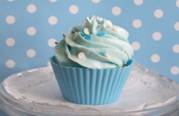A few days ago we found some information on one of our favorite websites, Care2.com, about how color affects the appetite. Melissa Breyer had this to say:

“Think about the color of the food you eat on a daily basis. There’s probably a lot of leafy green, some nice fruity reds and oranges, cereal browns and dairy whites. But how about blue? Okay, maybe blueberries qualify, or if you have an exuberant potato vendor at your farmers market you may be getting some blue-ish potatoes – but in general blue isn’t the favorite child in nature’s scheme of food hues. Consequently, we haven’t evolved an automatic appetite response to blue – in fact, our primal instinct seems to tell us to step away from the blue food.”
She goes on to explain that according to color professor J.L. Morton, our earliest ancestors (food foragers), saw blue, purple and black as “color warning signs” of potentially lethal food. Food researchers agree – when humans searched for food, they learned to avoid toxic or spoiled objects, which were often blue, black, or purple. When food dyed blue is served to study subjects, they lose their appetite. The science is certain — certain colors suppress the appetite while others excite it. (And you can imagine the amount of research processed food companies put in to extract such make-or-break information!) And blue constantly wins the least-appetizing color award. We can relate — we’ve always found blue food creepy, but we always assumed it was because of the dye – now we know there’s more to it.

While blue is considered an appetite-suppressing color, researchers often point to warm colors as appetite-stimulating. According to the Rohm and Haas Paint Quality Institute, red is a powerful color that increases blood pressure and heart rate.
It often produces feelings of intimacy, energy, passion and sexuality. It also stimulates the appetite – and is frequently used in restaurants and is an excellent choice for dining rooms in the home. Yellow is also an appetite-stimulating color as is associated with energy and happiness. (Hmmm. Red and yellow. Maybe that explains 31,000 McDonald’s locations worldwide?) This is why many designers recommend warm colors for home kitchens and restaurants – not only does it increase the appetite, but it has been shown to increase the speed at which people eat. Blue is rarely recommended: it slows us down and makes us want to go to sleep.

So what can this information mean to us? Those with children still dining at home might want to insert more yellow tableware, tablecloth, napkins, wall color, and especially food choices. Those dealing with blood pressure issues might want to tone down the red in the room. And those with sleep issues might want to increase the blue — maybe blueberry yogurt with extra added blueberries as an evening snack. Something certainly worth thinking about!
Contribute to the Cook'n Club!
DVO would love to publish your article, prose, photography and art as well as your cooking, kitchen and nutrition tips, tricks and secrets. Visit the Newsletter Submission / Win Win for All section in our Forum for more information and details.


